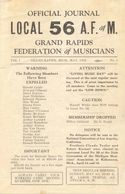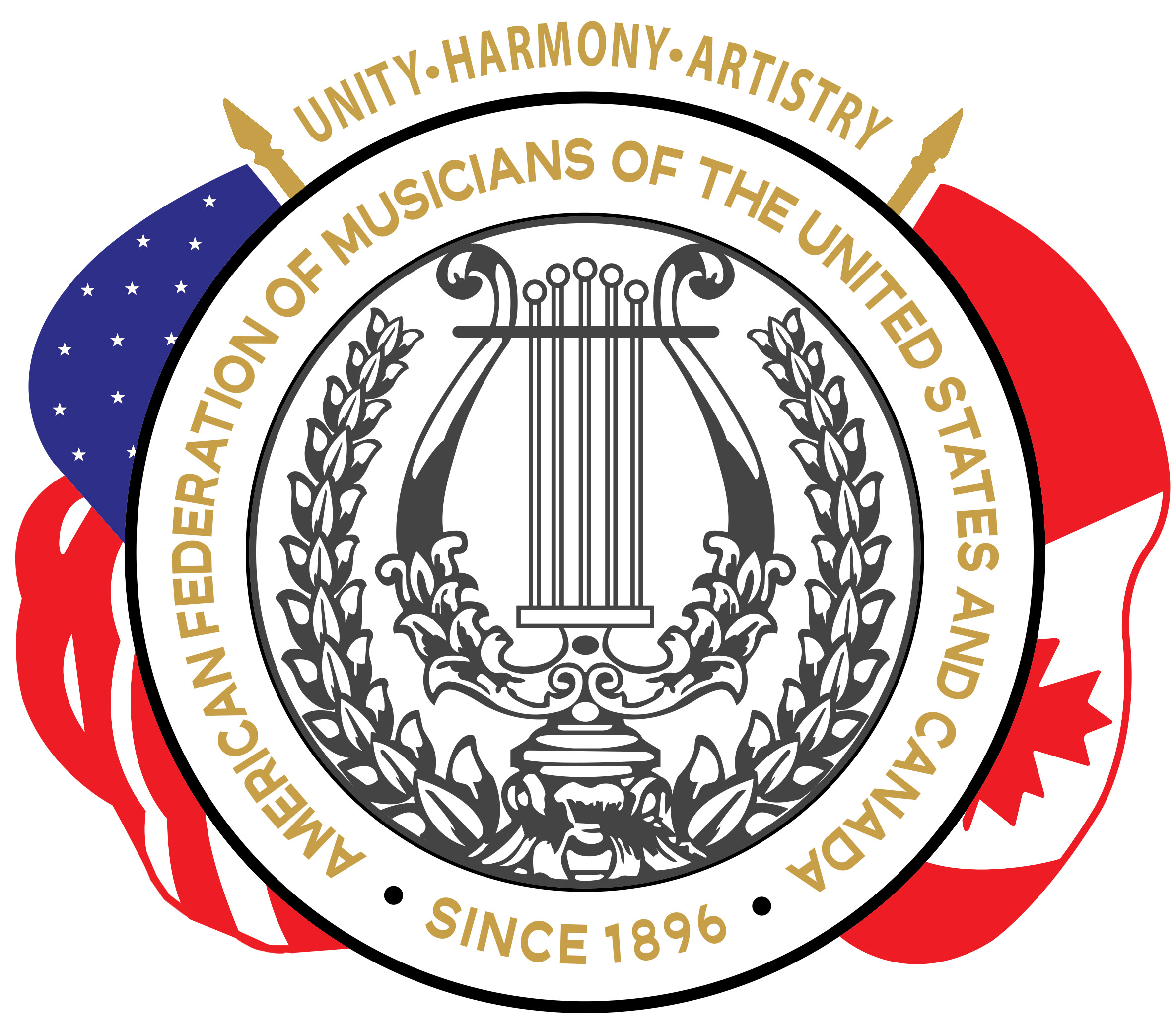
Musicians Celebrate 100 Years of Unity
The Grand Rapids Federation of Musicians celebrated its 100th anniversary in 2005. It was chartered as Local 56 of the American Federation of Musicians of the U.S. and Canada on Sept. 5, 1905. The goals were to unite instrumental musicians “for the better protection of [their] interests in general, and the establishment of a minimum rate of prices to be charged…for their professional services and the enforcement of good faith and fair dealing between its members.”
A number of special events and activities were scheduled in celebration of this milestone. These included a 100th Anniversary Membership Drive; and a reception to celebrate our 100th anniversary to be held following the Grand Rapids Symphony summer concert, called Beach Music on a Summer Night, at Cannonsburg Ski Area on Friday, July 22; Local 56 bands provided opening music before each of the GR Symphony summer series concerts at Cannonsburg Ski Area on Thursdays and Fridays, July 14-15, 21-22, 28-29, and August 4-5. An additional reception was held in October in the Lansing area.
GRFM History
1886 – Fifteen Musical Protective Unions from across the U.S. form the National League of Musicians.
1891 – Officers of the Musicians’ Mutual Protective Union of Grand Rapids, Michigan, Local 21 of the National League of Musicians, U.S.A.: Pres., Frank Braun; Vice-Pres., C. E. Fink; R. and C. S., Charles A. Hauser; F. C., D. E. Smith; Treas., Louis Martin; Board of Directors; Frank Braun, C. A. Hauser, Wilber Force, Orris Bonney, Fred Heald. (Information from History of the City of Grand Rapids, Michigan -With an Appendix–History of Lowell, Michigan, by Albert Baxter ; New York and Grand Rapids: Munsell & Company, Publishers, 1891.)
1892 – The earliest official record we have is a booklet containing the Constitution & Bylaws of the Musicians’ Mutual Protective Union of Grand Rapids, Michigan, Local 21 of the National League of Musicians, U.S.A. 106 members. Jurisdiction appears to have been the city of Grand Rapids and the immediate surrounding area.
1896 – The American Federation of Musicians is formed, consisting of 21 Locals. The name is lengthened to the American Federation of Musicians of the United States and Canada in 1900.
1904 – The National League of Musicians dissolves.
Sept. 5, 1905 – Grand Rapids area musicians become chartered as the Musicians’ Protective Association, Local 56 of the AFM of Grand Rapids, MI. The annual Convention of the AFM was held in Detroit.
May 8-12, 1922 – Local 56 hosts the annual Convention of the American Federation of Musicians. Musicians are losing employment opportunities due to WWI and Prohibition.
1924 – Local 56 Board of Directors:
Pres. Ernest Krapp, Vice Pres. A. S. Clifford, Sec. Claude O. Taylor, Financial Sec. Robert Kuenzel, Treasurer John Zink, Sergeant-at-Arms Arthur Hinsdill, Bd Members John Jarosch, A. Lawton, William Rose.
1925 – In a letter to the Local 56 Board, non-member Paul Seeds mentions “the Ku Klux Band” that had recently disbanded. Seeds had taken the position of band director just prior to its demise and subsequently formed the Paul Seeds Concert Band, which was later put on the AFM “Unfair List” for playing competitive engagements using non-union musicians.
April 14, 1925 – Mr. Wecker, conductor of the Grand Rapids Symphony Orchestra, appeared before the Board to seek the cooperation of the Local 56 Motion made and approved to do so.
Aug. 2, 1925 – “The secretary reported as delegate to the Trades and Labor Council and suggested that Local 56 purchase a box of cigars to give the members an opportunity of trying a new brand of union made cigars. It was regularly moved, supported and carried that the Local purchase a box of cigars for every meeting for some time.”
Sept. 13, 1925 – Local 56 affiliates with the Michigan Federation of Labor.
Contracts for musicians playing vaudeville shows mentioned with the Regent Theatre, Majestic Theatre, the Temple Theatre, Majestic Gardens, the Powers Theatre, the Orpheum Theatre, and the Empress Theatre.
1932 – Local 56 Board of Directors:
Pres. Ernest Krapp, Vice Pres. Robert Wilkinson, Financial/Recording Sec. Leon Knapp, Treasurer George Johnston, Bd Members John Jarosch, William Rose, Emmett Brandt.
March 6, 1932 – The Board wrote a letter of commemoration and sent it to Washington D. C. “on the sudden death of the world beloved Bandmaster John Philip Sousa.” A note with a handwritten comment was later received by the Local from Mrs. Sousa.

Click the picture for a larger view.
March 21, 1932 – Committee of four appointed to confer with conductor Karl Wecker to draft an agreement between Local 56 and the Grand Rapids Symphony Orchestra. A copy was submitted to the Local 56 Board for approval in April of 1932.
An incident at Palace Gardens: “Brother Merle McHattie was present to give his version of the Palace Gardens fiasco. He stated that Bro. Harold White broke his contract with Miss Brown, proprietor of Palace Gardens and engaged in a heated controversy with Miss Brown in a manner unbecoming to a gentleman. He also testified that Bro. White signed a public nuisance warrant against the owners of Palce Gardens causing the place to be raided and closed, thereby disengaging four members of Local 56 from earning a livelihood. The Secretary was instructed to order Bro. White to appear before the Board at their next meeting.”
April 11, 1932 – Mention of scale reductions at Ramona Theatre and an agreement between the Local and the Moving Picture Operator’s Union regarding the operation of “unsynchronized music”.
April 14-15, 1932 – Delegates from Local 56 attend the Michigan Musicians Association in Kalamazoo. Issues discussed included competition from prison bands, professional musicians teaching in public schools, and creation of a “Living Music Day”, a national campaign sponsored by the AFM to “interest Americans in hearing flesh and blood musicians instead of being content with even the most ingenious of mechanical substitutes.” On June 14, Living Music Day is held in Grand Rapids, sponsored by Local 56 and the Grand Rapids Herald. Nine local bands perform free concerts at 10 AM and 2 PM at area businesses, followed by a 7:30 PM concert in Fulton Street Park by the 75-piece Furniture City band.
May 1, 1932 – Following the reading of a letter from AFM President Webber regarding a plan for “colored membership”, the Local 56 Board adopted the plan and instructed the Secretary to “take applications from colored musicians”. Many metropolitan areas in the U.S. chartered separate AFM Locals for blacks and whites, which were gradually merged throughout the 1950’s & 60’s.
May 1932 – First Local 56 Bulletin printed and distributed to members. The Board decides to make it a quarterly publication.

Click on newsletter for a larger view
Feb. 1933 – Secretary Knapp was instructed to write state senators and representatives, as requested in a letter from the AFM President, urging them to approve a measure to abolish prohibition.
April 1933 – The Michigan Musicians Conference discussed the negative effects the Depression was having on musicians, including lowering of scales, lack of work, and increased competition from school bands. Sec. Knapp of Local 56 stated that the future of all Locals lies in recruiting young musicians into membership. It was hoped that the possible repeal of the Eighteenth Amendment would open up additional employment opportunities.
June 1933 – A member charged with “importing musicians” from Indiana replied that “there were no men in Grand Rapids that were really showmen and that what he needed was men that could play at least six instruments and sing and double a[t] tap dance.” The club manager stated that he was the one who communicated with the Indiana musicians in ignorance of Local bylaws. The member was lectured on Local bylaws and the case was dismissed.
March 1934 – Regular Association Meeting, Sunday, March 4 – “The Secretary spoke on the subject of accepting colored members and the new aspect of the matter as the Local had recently stopped a colored from filling an engagement in the Civic Auditorium. The matter was discussed pro and con and after much deliberation motion was made and carried to accept applications of colored musicians. Bro Taylor wished his vote to be recorded in the negative.”
May 1934 – The Board discussed the loss of work to union musicians who were honoring a dispute between the Stage Hands union and St. Cecilia Music Society. It was expected that the forthcoming AFM Convention would be investigating and seeking remedies for loss of work due to National Radio Networks attempting to force Local Radio Stations to program network shows, forcing local radio shows off the air.
1935 – Local 56 Board of Directors:
Pres. Robert C. Wilkinson; Vice Pres. DeForest Poole; Secretary Leon Knapp; Treasurer George H. Johnson; Donald Patterson; Leland Jarosch.
April 8-9, 1937 – the annual meeting of the Michigan Musicians Association was held at the Pantlind Hotel, hosted by Local 56.
1942-44 – Local 56 supports the AFM’s strike against the recording industry. The strike resulted in the establishment of the Music Performance Trust Funds (MPTF), an independent fund overseen by representatives of the Recording Industry (major recording labels) and the AFM. MPTF receives a percentage of the proceeds from the commercial sale of recorded music, which is then administered by AFM Locals throughout the U.S. to help pay musicians who provide live music free to the public.
The AFM also pressured NBC to cancel the broadcasting of student concerts at the Interlochen National Music Camp, claiming unfair competition with professional radio staff musicians, which led to the adoption of the Music Code of Ethics between the AFM and the Music Educators National Conference in 1947. This code creates an awareness among music educators of the distinction between allowing students to perform as a public service and putting student bands in competition with musicians who earn a livelihood with their craft.
1948 – Jurisdiction included counties of Kent, Montcalm, Mecosta, Clare, Isabella and Ottawa (except Grand Haven, Spring Lake and Spring Lake Country Club).
1961 – Local 56 begins awarding summer music scholarships to students through the AFM’s Congress of Strings program, continuing to award scholarships with its own program after the AFM program ceases in 1990.
Jan. 1, 1991 – Local 56 assumed jurisdiction of former Bay City Local 127.
Jan. 1, 1992 – Local 56 merged with Muskegon Local 252.
Jan. 1, 2003 – Local 56 assumed jurisdiction of former Lansing Local from Jackson Local 387.
